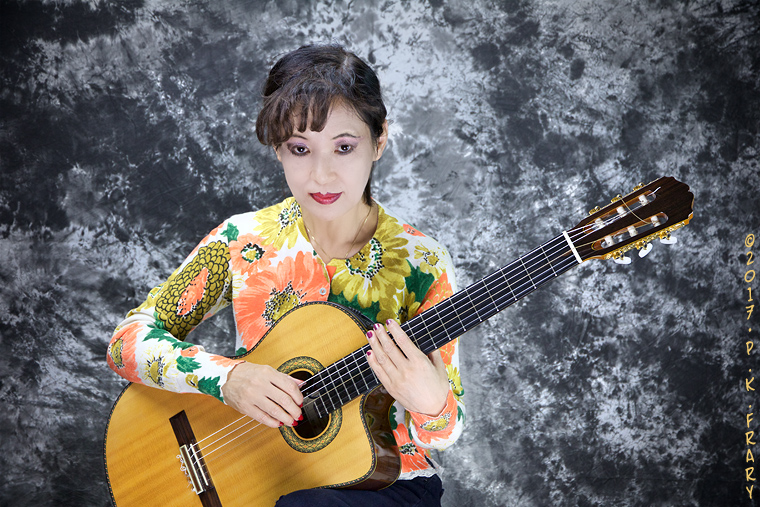|
3 | Musical ElementsString InstrumentsPeter Kun Frary
.
|
Paleolithic Origins?Where did string instruments come from? The answer is lost in the mists of time. However, ethnomusicologists have long hypothesized the twang of a hunting bow may have led to the development of string instruments by Paleolithic humans. Indeed, ethnomusicologists have observed hunting bows being used as musical bows by Bushmen and other indigenous hunter-gather populations in Africa. Thus, it is not unreasonable to imagine an evolutionary progression from bow to harp, rebab, guitar and so forth. |
|
The string or chordophone family divides into two broad categories: bowed chordophones and plucked chordophones.
'Ukulele | The 'ukulele, played by Kalei Gamiao, is a chordophone closely related to the guitar and Portuguese braguinha | Peter Kun Frary

 Plucked String Instruments
Plucked String Instruments
Plucked string instruments create sound by picking, striking or pulling the string and include instruments like the pipa (琵琶), koto (箏), guitar, ʿūd (عود) and harp.
Listen to the sound of a plucked chordophone, the archlute:
Prelude in C Minor "pour le luth" BWV 999 | Johann Sebastian Bach, 1685-1750 | David Tayler, archlute (2:21)
The 'ukulele is a small member of the guitar family. In terms of sound, it is surprisingly similar to the guitar and lute:
Kawika | ʻUkulele star, Brittni Paiva, performs on a tenor 'ukulele (3:06).
Plucked string chordophones share similar terminology for their parts. For example, the 'ukulele has the same part names as the guitar, mandolin and bass guitar:

 Families of Instruments
Families of Instruments
String instruments, like brass and wind instruments, exist in multiple sizes, roughly approximating SATB vocal ranges. For example, the guitar family includes the bass guitar, baritone guitar, guitar, alto guitar, and piccolo (soprano) guitar:
Concerto in C Major RV425 | Antonio Vivaldi, 1678-1741 | Zoo Guitar Duo and the Missing Person Guitar Quintet (9:08)
 Bowed String Instruments
Bowed String Instruments
Musicians create sound on a bowed chordophone by drawing a bow across the strings. In Western music, string instruments played with a bow—a stick strung with horse hair—belong to the violin family and include the violin (soprano), viola (alto) cello (bass) and double bass.
Violin | Most violin part names are the same for the cello, viola and double bass. The cello and double bass lack the chin rest but have a spike for floor use.

Violin
The violin is a popular bowed chordophone used extensively in classical, folk, popular and Non-Western genres. Listen to Mr. Visontay talk about the violin:
Violin | Zsolt-Tihamér Visontay introduces the violin (8:39)
Cello
The cello—depicted above under "pizzicato"—is a large bowed chordophone and bass member of the violin family—lower in pitch than the violin and viola. It's often heard on bass parts in orchestra and chamber music but can shine as a soloist.
Prelude, Cello Suite 1 | Johann Sebastian Bach, 1685-1750 | Tina Guo (2:34)
String Ensemble
A family of bowed instruments playing together produces a blended sound similar to a SATB choir. Astor Piazzolla's Oblivion for Violin and String Orchestra features all the common members of the violin family: violin, viola, cello and bass violin:
Oblivion | Astor Piazzolla, 1921-1992 | Rusanda Panfili (violin solo) with the Hilaris Chamber Orchestra (5:16)
 String Instrument Techniques
String Instrument Techniques
Techniques significant to the unique sound of string instruments include: vibrato, harmonics, double stop, tremolo and pizzicato.
Vibrato
The technique of rapidly fluctuating a musical tone slightly sharp and flat, thereby enhancing and sweetening the note, is called vibrato. Vibrato is created by pressing the string on the fingerboard and shaking or rocking the finger. Observe the vibrato, i.e., left hand shakes, in the video below:
Torija | Federico Moreno Torroba, 1891-1982 | Peter Kun Frary (2:14)
Double Stop
Double stop is the technique of playing two notes simultaneously; triple stop means three notes are played, and so on. It is a difficult technique on bowed instruments such as violin or cello but relatively simple to execute on guitar or ukulele. Triple stops begin at 0:16 in the video below:
Billie Jean | Michael Jackson, 1958-2009 | Barcelona Guitar Trio and Paquito Escudero, percussion (2:11)
Harmonic
On string instruments, high pitched bell-like tones, called harmonics, may be created by lightly touching strings at nodal points. Listen to Cory Fujimoto play harmonics during the beginning (intro) of Somewhere Over The Rainbow:
Somewhere Over The Rainbow | Cory Fujimoto, Kanilea guitalele (4:05)
Tremolo
Tremolo is a rapid reiteration of a note. It is created by repeating notes with small but rapid down-up bow strokes in the violin family or repeated strokes with a finger or pick on plucked string instruments such as the guitar or ukulele.
El Último Trémolo | Augustin Barrios, 1885-1944 | Erika Otani, guitar (3:43)
Pizzicato
The technique of plucking the strings of a violin, viola, cello or similar bowed stringed instrument is called pizzicato.
Street Pizzicato | The cello is a bowed chordophone and bass member of the violin family. | Portland, Oregon | Peter Kun Frary

When bowed instruments such as the violin are plucked, the resulting tones are soft and short in sustain:
CHUSETS - Violin Pizzicato Caprice | Nino Cotone, violin (2:02)
Vocabulary
organology, chordophone, vibrato, tremolo, harmonics, double stop, triple stop, pizzicato, guitar, violin, cello, viola, double bass, viol, Hornbostel-Sachs system
 |
 |
©Copyright 2018-25 by Peter Kun Frary | All Rights Reserved



